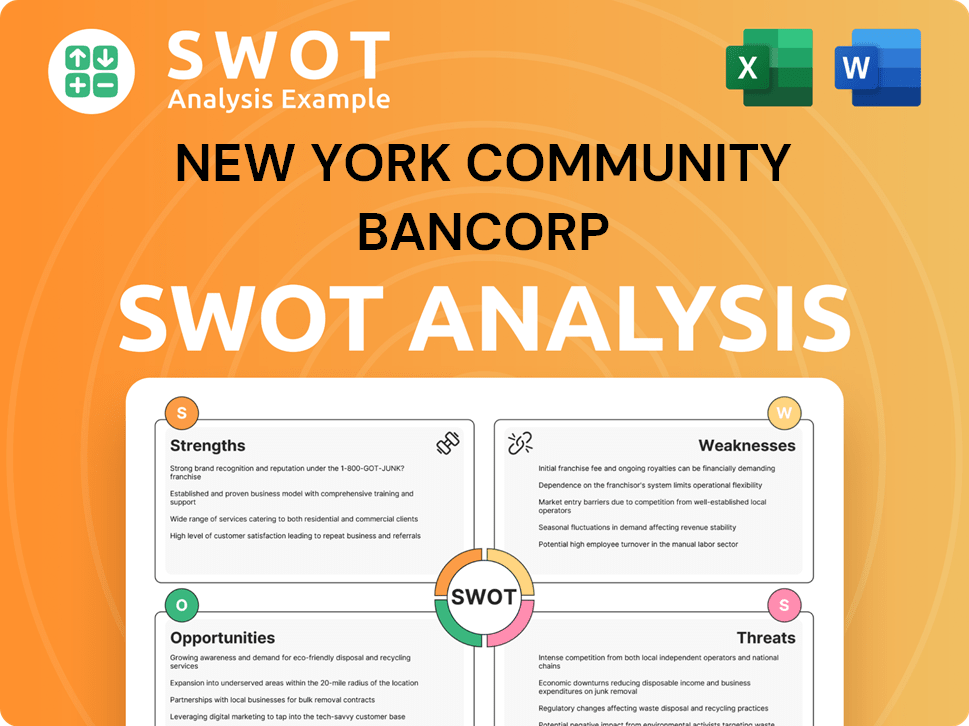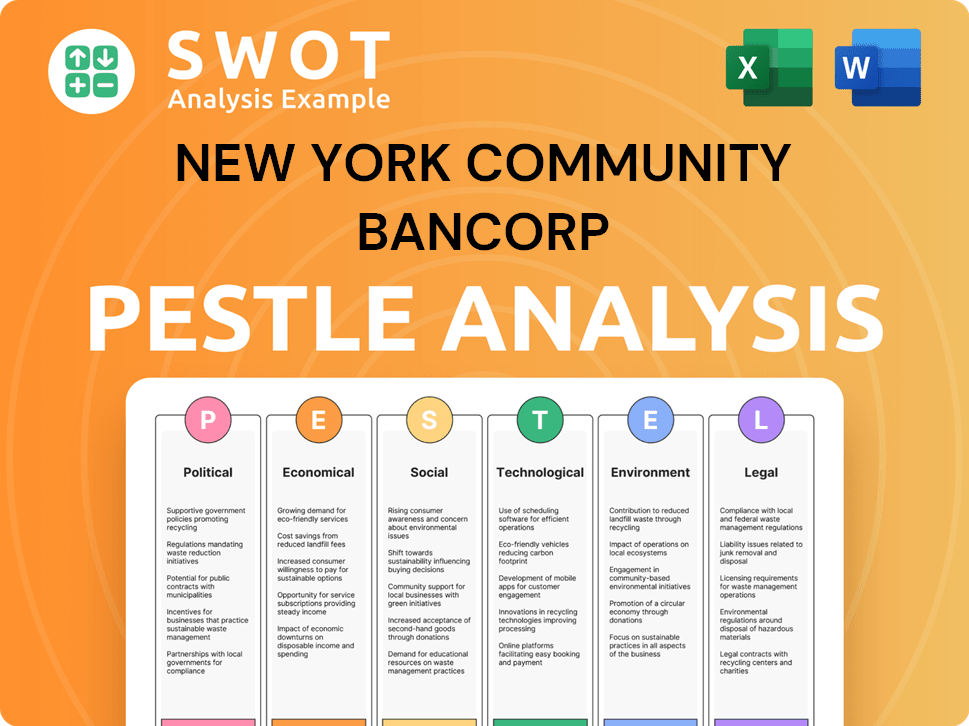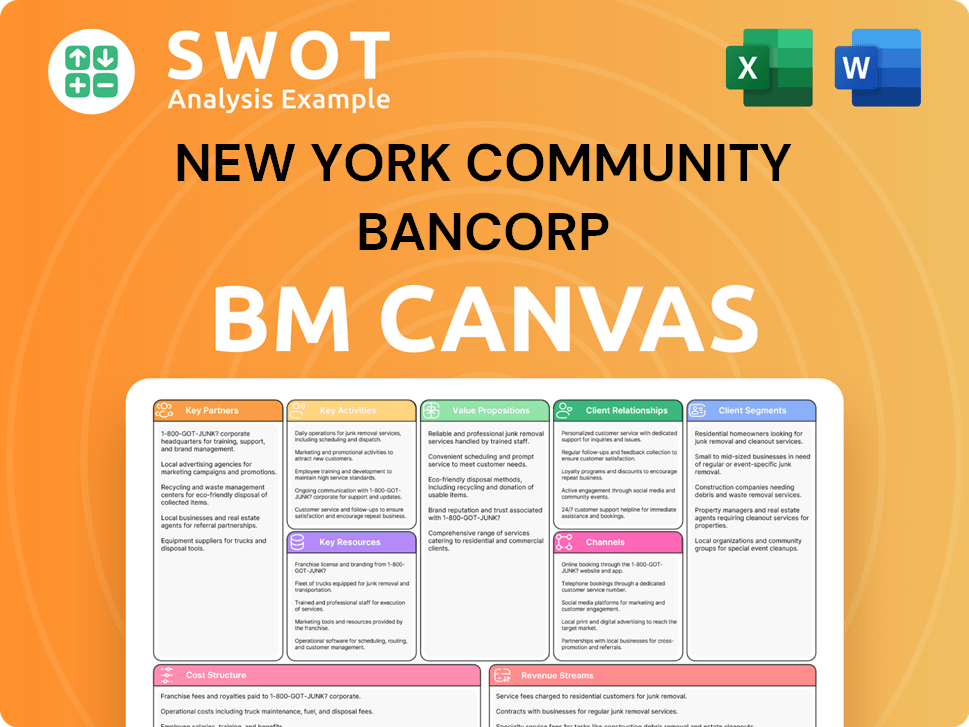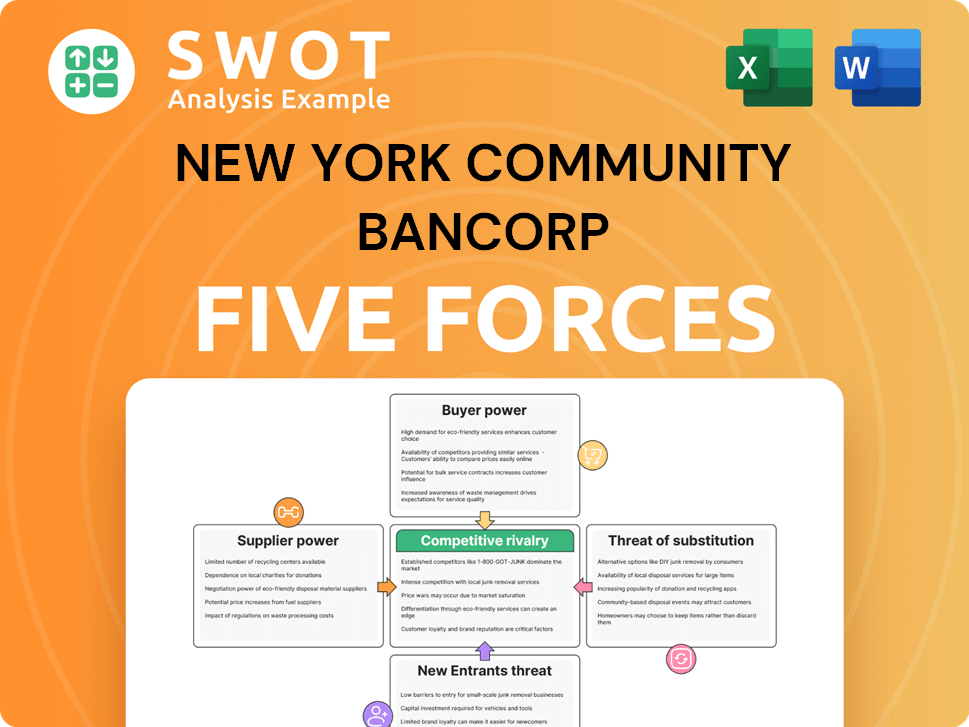New York Community Bancorp Bundle
Can Flagstar Financial (formerly NYCB) Navigate the Turbulent Banking Waters?
New York Community Bancorp (NYCB), now known as Flagstar Financial Inc., has undergone a significant transformation, evolving from a local savings bank into a major regional player. This journey, marked by strategic acquisitions and a rebranding in late 2024, has reshaped its position within the New York Community Bancorp SWOT Analysis. But what does this mean for its competitive standing in the fast-paced financial services industry?

This market analysis will dissect the competitive landscape of NYCB, evaluating its key rivals and strategic advantages. We will explore the impact of recent financial performance, including significant losses, and the strategic initiatives undertaken to ensure future growth. Understanding NYCB's market position and challenges is crucial for investors and analysts seeking to navigate the complexities of the banking industry.
Where Does New York Community Bancorp’ Stand in the Current Market?
As of March 31, 2024, New York Community Bancorp (NYCB), operating as Flagstar Financial Inc., held a significant position in the banking industry with total assets of $112.9 billion. The company's core operations include traditional banking services, with a strong presence in the Northeast and Midwest, and expansion into high-growth markets in the Southeast and West Coast.
The value proposition of NYCB lies in its diverse financial services, including a substantial mortgage business through Flagstar Mortgage. This unit was the seventh-largest bank originator of residential mortgages for the 12 months ending March 31, 2024, and a major mortgage sub-servicer. Additionally, NYCB is a leading mortgage warehouse lender.
NYCB operates a network of 419 branches, primarily in the Northeast and Midwest. The company is actively expanding into high-growth markets in the Southeast and West Coast. This strategic expansion aims to diversify its geographic footprint and reduce reliance on specific regional economic conditions.
Flagstar Mortgage plays a crucial role, ranking as a top mortgage originator and sub-servicer. For the 12 months ending March 31, 2024, it was the seventh-largest bank originator. The company services 1.4 million accounts with $367 billion in unpaid principal balances, highlighting its significant role in the mortgage market.
NYCB is strategically reducing its reliance on commercial real estate (CRE) loans to diversify its portfolio. In the second quarter of 2024, CRE loans decreased by $362 million year-over-year. The company's multifamily portfolio was reduced to $33.9 billion at the end of June 2024, down from $35.4 billion as of June 30, 2023.
The company's net interest margin for the third quarter of 2024 was 1.79%, a decrease of 19 basis points compared to the second quarter of 2024. This reflects the impact of market conditions and strategic shifts. For more details on the strategic direction, see Growth Strategy of New York Community Bancorp.
New York Community Bancorp SWOT Analysis
- Complete SWOT Breakdown
- Fully Customizable
- Editable in Excel & Word
- Professional Formatting
- Investor-Ready Format

Who Are the Main Competitors Challenging New York Community Bancorp?
The competitive landscape for Flagstar Financial, formerly known as New York Community Bancorp (NYCB), is complex. The banking industry is highly competitive, with numerous players vying for market share. This competition impacts NYCB's financial performance and strategic decisions.
Flagstar Financial faces both direct and indirect competition. Understanding the competitive dynamics is crucial for investors and stakeholders interested in Marketing Strategy of New York Community Bancorp and its future prospects. This analysis provides a comprehensive overview of NYCB's key competitors and the challenges they pose.
The competitive environment for NYCB is dynamic, influenced by market trends, economic conditions, and strategic moves by its rivals. A thorough market analysis reveals the strengths and weaknesses of NYCB compared to its peers.
NYCB's primary competitors include major national and regional banks. These institutions compete across various financial services, from retail banking to commercial lending. Understanding who these competitors are is vital for assessing NYCB's market position.
Large national banks, such as Bank of America, are significant competitors. They offer a wide array of services and have extensive branch networks. Their size allows for economies of scale, potentially offering more competitive pricing.
Regional banks, including First Citizens BancShares Inc., M&T Bank Corp., and Regions Financial Corp., compete directly in NYCB's core markets. These banks often focus on similar services, such as multi-family lending and retail banking.
Other active competitors include Metro Bank, Investec, and Virgin Money. These institutions may focus on niche markets or offer specialized financial products. Apple Federal Credit Union, with an annual revenue of approximately $1.3 billion, also competes in the financial services sector.
Fintech companies present a growing competitive threat. They leverage technology to offer innovative and streamlined financial products. These companies can disrupt traditional banking models.
Mergers and alliances within the banking industry continuously reshape the competitive landscape. These strategic moves can alter market share and competitive dynamics, affecting NYCB's position.
NYCB faces various challenges in this competitive environment. These challenges include competition from larger banks, regional banks, and fintech companies. Understanding these challenges is important for evaluating NYCB's strategic initiatives and future growth potential.
- Broader Service Offerings: Larger national banks provide a more comprehensive range of services, making it difficult for NYCB to compete on breadth.
- Pricing and Scale: National banks often have lower pricing due to economies of scale, which can impact NYCB's profitability.
- Market Share: Regional banks compete directly in NYCB's core markets, affecting its market share.
- Technological Innovation: Fintech companies introduce innovative products, challenging traditional banking models.
- Regulatory Environment: Changes in regulations can impact all competitors, creating both challenges and opportunities.
New York Community Bancorp PESTLE Analysis
- Covers All 6 PESTLE Categories
- No Research Needed – Save Hours of Work
- Built by Experts, Trusted by Consultants
- Instant Download, Ready to Use
- 100% Editable, Fully Customizable

What Gives New York Community Bancorp a Competitive Edge Over Its Rivals?
The competitive landscape for New York Community Bancorp (NYCB) is evolving, shaped by its strategic shifts and the broader dynamics of the banking industry. Historically, the company leveraged its specialized focus and strong presence in key markets, particularly in multi-family lending and mortgage services. Its deep roots in the New York metropolitan area, stemming from its history as Queens County Savings Bank and subsequent acquisitions, provided a significant competitive edge through established community ties and brand recognition.
However, recent challenges have prompted a strategic overhaul. The company's underwriting and risk management practices, previously misrepresented, led to significant loan loss provisions in late 2023 and early 2024. This has necessitated a transition towards a more diversified regional bank model, including efforts to reduce reliance on commercial real estate loans and expand into commercial and industrial lending. This shift is crucial for navigating the competitive pressures within the financial services sector.
A key element of this transformation is the $1.05 billion equity capital raise in March 2024, supported by investors like Liberty Strategic Capital. This capital injection is critical for stabilizing the company's finances and supporting its turnaround strategy. Understanding these changes is essential for investors and stakeholders looking at the Owners & Shareholders of New York Community Bancorp and its future prospects.
NYCB's market position is primarily in the New York metropolitan area, with a focus on multi-family lending. The company has been working to expand its commercial and industrial lending portfolio to diversify its revenue streams. This diversification is a key strategic initiative to enhance its competitive position within the banking industry.
Historically, NYCB's advantages included a strong presence in multi-family lending and a well-established brand in the New York area. The company's deep local roots and community ties provided a competitive edge. The current strategic shift aims to leverage these strengths while addressing weaknesses in risk management and diversifying its loan portfolio.
The company faces challenges related to its loan portfolio, particularly in commercial real estate. Weaknesses in underwriting and risk management, as highlighted by significant loan loss provisions, pose a risk. The evolving interest rate environment and competition from other regional banks also create challenges.
Key initiatives include reducing exposure to commercial real estate loans and expanding into commercial and industrial lending. Bolstering capital levels through the $1.05 billion equity raise is a crucial step. The company is also focused on improving its risk management practices and enhancing its overall financial performance.
NYCB's competitive standing hinges on several factors, including its ability to successfully execute its strategic shift. The company's performance will be influenced by its ability to manage its loan portfolio and adapt to changing market conditions. Furthermore, its ability to attract and retain customers in a competitive environment is essential.
- Diversification of the loan portfolio to reduce risk.
- Strengthening risk management practices to prevent future losses.
- Expanding into commercial and industrial lending to increase revenue.
- Maintaining a strong capital position to withstand economic downturns.
New York Community Bancorp Business Model Canvas
- Complete 9-Block Business Model Canvas
- Effortlessly Communicate Your Business Strategy
- Investor-Ready BMC Format
- 100% Editable and Customizable
- Clear and Structured Layout

What Industry Trends Are Reshaping New York Community Bancorp’s Competitive Landscape?
The banking industry is currently experiencing significant shifts driven by technological advancements, evolving regulatory environments, and changing consumer preferences. These trends are reshaping the competitive landscape, with digital transformation and regulatory scrutiny playing crucial roles. For New York Community Bancorp (NYCB), understanding and adapting to these changes is essential for maintaining and improving its market position within the financial services sector. This includes a detailed market analysis to identify opportunities and mitigate risks.
NYCB's future outlook involves navigating challenges and capitalizing on opportunities within a dynamic market. The bank's strategic initiatives, coupled with its financial performance, will be key to its success. The competitive landscape demands a proactive approach to address both internal and external factors, ensuring long-term sustainability and growth. You can find more information regarding the company's revenue streams and business model in this article: Revenue Streams & Business Model of New York Community Bancorp.
Technological advancements are driving digital transformation, with increasing demand for online and mobile banking. Regulatory changes, particularly after recent banking turmoil, are leading to increased scrutiny and tighter lending standards. Shifts in consumer preferences are also impacting the banking industry, requiring banks to adapt to evolving customer needs.
Continued volatility in interest rates poses a significant challenge, impacting profitability and lending activities. Aggressive competition from both traditional and non-traditional financial institutions creates pressure on market share. The ongoing need to improve internal controls and risk management is crucial for maintaining stability and compliance.
Strategic repositioning as a diversified regional bank allows for expansion into new markets and service offerings. Leveraging its established presence and customer base provides a foundation for growth. Recent capital infusions and new management teams can drive strategic initiatives and improve financial performance.
Diversifying the loan portfolio, particularly pushing further into commercial and industrial (C&I) lending, is a key strategy. The goal is to grow C&I loans to $30 billion in the next three to five years. Aiming for profitability by the end of 2026, with targets of a 1% return on average earnings assets and an 11% to 12% return on average tangible common equity.
NYCB faces headwinds from the commercial real estate market, which is impacted by higher interest rates and work-from-home trends. The company's recent capital infusion and new management team are critical for navigating these challenges. The long-term effort focuses on achieving sustained profitability and strengthening its competitive standing in the regional banks in New York sector.
- NYCB aims to reduce its vulnerability to the commercial real estate market.
- The company expects to post a loss for 2025 but targets profitability by the end of 2026.
- Key performance indicators include a 1% return on average earnings assets and an 11%-12% return on average tangible common equity.
- The strategic focus is on long-term sustainability and strengthening its competitive position.
New York Community Bancorp Porter's Five Forces Analysis
- Covers All 5 Competitive Forces in Detail
- Structured for Consultants, Students, and Founders
- 100% Editable in Microsoft Word & Excel
- Instant Digital Download – Use Immediately
- Compatible with Mac & PC – Fully Unlocked

Related Blogs
- What are Mission Vision & Core Values of New York Community Bancorp Company?
- What is Growth Strategy and Future Prospects of New York Community Bancorp Company?
- How Does New York Community Bancorp Company Work?
- What is Sales and Marketing Strategy of New York Community Bancorp Company?
- What is Brief History of New York Community Bancorp Company?
- Who Owns New York Community Bancorp Company?
- What is Customer Demographics and Target Market of New York Community Bancorp Company?
Disclaimer
All information, articles, and product details provided on this website are for general informational and educational purposes only. We do not claim any ownership over, nor do we intend to infringe upon, any trademarks, copyrights, logos, brand names, or other intellectual property mentioned or depicted on this site. Such intellectual property remains the property of its respective owners, and any references here are made solely for identification or informational purposes, without implying any affiliation, endorsement, or partnership.
We make no representations or warranties, express or implied, regarding the accuracy, completeness, or suitability of any content or products presented. Nothing on this website should be construed as legal, tax, investment, financial, medical, or other professional advice. In addition, no part of this site—including articles or product references—constitutes a solicitation, recommendation, endorsement, advertisement, or offer to buy or sell any securities, franchises, or other financial instruments, particularly in jurisdictions where such activity would be unlawful.
All content is of a general nature and may not address the specific circumstances of any individual or entity. It is not a substitute for professional advice or services. Any actions you take based on the information provided here are strictly at your own risk. You accept full responsibility for any decisions or outcomes arising from your use of this website and agree to release us from any liability in connection with your use of, or reliance upon, the content or products found herein.